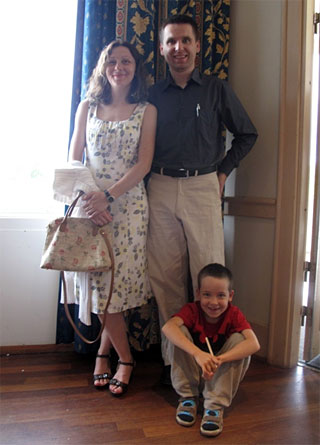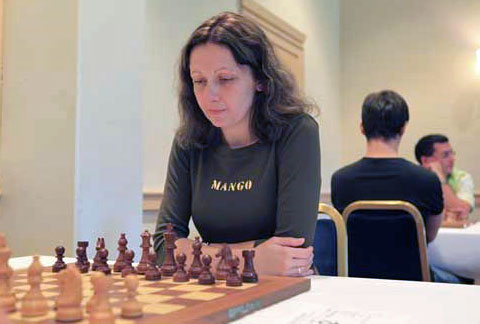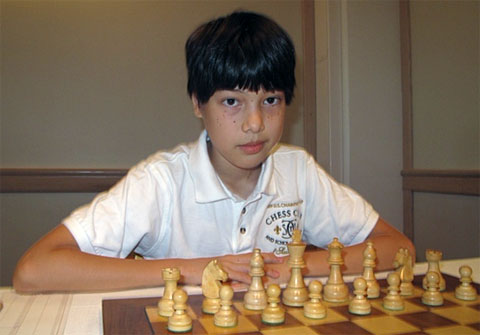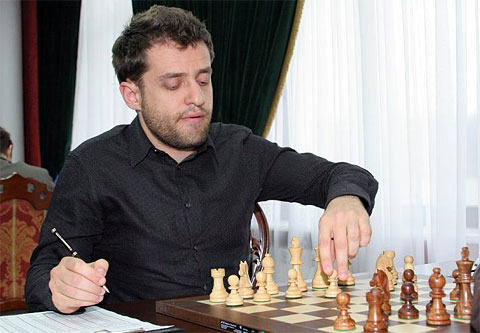| Latest | Greatest | Lobby | Journals | Search | Options | Help | Login |
|
|
|
This topic is archived. |
| Home » Discuss » Topic Forums » Sports |
|
| Jack Rabbit
|
Sun Aug-09-09 11:22 AM Original message |
| The JR Chess Report (August 9): Arctic Open ends in four-way tie, Mrs. Socko with best tiebreaks |
|
Monika Socko, Young Yank Robson, Petrov & Berg Share First in Arctic
 Polish grandmaster Monika Socko, 14-year-old American international master Ray Robson, IM Marijan Petrov of Bulgaria and reigning Swedish national champion Emanuel Berg tied for first place in the fourth annual Arctic Chess Challange that finshed a few minutes ago in Troms�, a town on the Arctic coast of Norway. Mrs. Socko (pronounced ZOTCH koh) becomes the second woman this year to share first place in a major mixed-gender Swiss system tournament. In May, Indian GM Koneru Humpy shared first in the Mayor's Cup in Mumbai. It appears at this writing that Mrs. Socko will take home the trophy with the superior tiebreak score. Each member of the foursome finished with 7 points in nine rounds. The tournament's top seed, Polish GM Bertosz Socko, finished with 6 points, a full point behind his wife. One other member of the Socko family competed in Troms�. Seven-year-old Szymon Socko scored two points with two victories.  The Chess-Playing Socko Family of Poland Grand Prix Tournament Begins in Armenia  The FIDE Grand Prix started its most recent leg in the Armenian town of Jermuk today. Fourteen of the world's leading grandmasters are participating: Vladimir Akipian, Evgeny Alekseev, Levon Aronian, Etienne Bacrot, Ivan Cheparinov, Pavel Eljanov, Boris Gelfand, Ernesto Inarkiev, Vassily Ivanchuk, Dmitry Jakovenko, Gata Kamsky, Sergey Karjakin, Rustam Kasimdzhanov and Peter Leko. The tournament in a thirteen game single round robin and runs through August 24. Simpson's Divan Hosts Staunton Memorial  The seventh annual Howard Staunton Memorial Tournament got underway yesterday at Simpson's Divan in London. This year's edition of the Stuanton is divided into two groups: a Scheveningen team tournament between Britain and Holland and the traditional round robin among ten players. The event lasts through August 17. Calendar International Festival d'�checs, Montreal 27 August-7 September. Grandmaster Tournament will include Bacrot, Onischuk, Shulman, Naiditsch and Maze; more to be added. Grand Slam Final, Bilbao 2-15 September. Topalov, Karjakin, Grischuk and Shirov qualify. Topalov dropped and will be replaced by Aronian. Second Pearl Spring Tournament, Nanjing 27 September-9 October. Topalov, Anand, Carlsen, Radjabov, Jakovenko and Wang Yue. World Junior Championship, Mar del Plata (Argentina) 16-29 October. European Club Cup (Team Championship), Novi Sad (Serbia) 21-31 October. World Cup, Khanty Mansiysk 28 November-15 December. London Chess Classic 7-16 December. Corus Chess Tournament, Wijk aan Zee 15-31 January 2010. Nakamura has been invited to play in group A. Anand-Topalov Match for the World Title, Site TBA c. April 2010. |
| Printer Friendly | Permalink | | Top |
| Jack Rabbit
|
Sun Aug-09-09 11:25 AM Response to Original message |
| 1. This week's games |
|
Your humble hare acknowledges the assistance of Fritz 6.0 on analysis. Diagrams on the Jack Rabbit Chess Report are made with Chess M�rida, a true type font that can be downlaoded free here. !""""""""# $tMvWlVmT% $OoOoOoOo% $ + + + +% $+ + + + % $ + + + +% $+ + + + % $pPpPpPpP% $RnBqKbNr% /(((((((() WHITE White to move (This position is a theoretical draw) |
| Printer Friendly | Permalink | | Top |
| Jack Rabbit
|
Sun Aug-09-09 11:27 AM Response to Reply #1 |
| 2. Arctic Chess Challenge, Troms� |
| Printer Friendly | Permalink | | Top |
| Jack Rabbit
|
Sun Aug-09-09 11:34 AM Response to Reply #2 |
| 5. Turner - M. Socko, Round 5 |
 Monika Socko To view this game:
Matthew Turner - Monika Socko Arctic Chess Challenge, Round 5 Troms�, 5 August 2009 Closed Sicilian Game: Saragossa Opening (Alapin Opening) 1.e4 c5 2.c3 d5 3.exd5 Qxd5 4.d4 Nf6 5.Be3
5...cxd4 6.cxd4 Bg4
7.Ne2
7...Nc6!?
8.Nbc3
8...Qa5 9.h3 Bf5
10.a3 e6 11.g4 Bg6
12.Bg2 Bd6!?
13.0-0
13...0-0
14.Qb3!?
14...Qa6 15.Nb5 Rfd8 16.Nec3 Rac8 17.Rac1
17...Na5
18.Qa4 Bb8 19.b3
19...Nc6 20.Rfd1 Ne7 21.Bg5 Qb6 22.d5 Nexd5
23.Nxd5 exd5 24.Be3 !""""""""# $ BtT +l+% $Oo+ +oOo% $ W + Mv+% $+n+ + + % $w+ + +p+% $Pp+ B +p% $ + + Pb+% $+ Rr+ K % /(((((((() WHITE: Matthew Turner Position after 24.Bg5e3 24...Rxc1!?
25.Rxc1!
25...Qe6
26.Bxa7 Bxa7 27.Qxa7 Ne4 28.Qxb7 Qf6 29.Rf1
29...Nd2 30.Rd1?
!""""""""# $ + T +l+% $+q+ +oOo% $ + + Wv+% $+n+o+ + % $ + + +p+% $Pp+ + +p% $ + M Pb+% $+ +r+ K % /(((((((() WHITE: Matthew Turner Position after 30.Rf1d1 30...Nf3+!
31.Kh1
31...Bc2 32.Rf1 Bd3
33.Rc1 Bxb5 34.Qxb5 Qf4 35.Bxf3
35...Qxc1+!
36.Kg2 d4 37.Qb6
!""""""""# $ + T +l+% $+ + +oOo% $ Q + + +% $+ + + + % $ + O +p+% $Pp+ +b+p% $ + + Pk+% $+ W + + % /(((((((() WHITE: Matthew Turner Position after 37.Qb5b6 37...Qg5!
38.a4 d3 39.a5 d2 40.Bd1
40...Qd5+ 41.Kg3 g6
42.b4 Re8 43.a6 Qh1 44.Ba4 Qa1!!
45.Bxe8 Qe5+ 46.Kg2 Qe4+ 47.Kg3 d1Q 0-1
|
| Printer Friendly | Permalink | | Top |
| Jack Rabbit
|
Sun Aug-09-09 11:36 AM Response to Reply #2 |
| 6. Robson - Urkedal, Round 4 |
|
Ray Rabson, 14, is a bright rising star in American chess. His father is an American professor and his mother is a nurse from Guam. The family lives in Florida.
 Ray Robson To view this game:
Ray Robson - Frode Olav Olsen Urkedal Arctic Chess Challenge, Round 4 Troms�, 4 August 2009 Open Sicilian Game: Najdorf-Scheveningen Defense (Chandler-Nunn Opening) 1.e4 c5 2.Nf3 d6 3.d4 cxd4 4.Nxd4 Nf6 5.Nc3 a6 6.Be3 e6
7.g4
7...h6
8.Bg2 Nc6 9.h3 Be7
10.f4
10...Qc7 11.Qe2 Nxd4
12.Bxd4 e5 13.Be3 exf4 14.Bxf4 0-0
15.0-0-0 Be6 16.e5!?
16...dxe5
17.Bxe5
17...Qb6 18.Bd4
18...Qc7 19.Qf2 Rac8
20.Bb6 Qb8
21.Rhe1!?
21...Rc4 22.Bf1 Rc6 23.Bd4 Qc8
24.Bd3 Bc5 25.Rf1 Bxd4
26.Qxd4 Bc4?
!""""""""# $ +w+ Tl+% $+o+ +oO % $o+t+ M O% $+ + + + % $ +vQ +p+% $+ Nb+ +p% $pPp+ + +% $+ Kr+r+ % /(((((((() WHITE: Ray Robson Position after 26...Be6c4 27.Rxf6!!
27...gxf6
28.Be4! Rc7
29.Bf5 Be6 30.Nd5 Bxf5 31.gxf5
31...Rxc2+ 32.Kb1 Qc5
33.Rg1+ Kh7 34.Qg4! 1-0 !""""""""# $ + + T +% $+o+ +o+l% $o+ + O O% $+ Wn+p+ % $ + + +q+% $+ + + +p% $oOt+ + +% $+k+ + R % /(((((((() WHITE: Ray Robson Final Position after 34.Qd4g4
|
| Printer Friendly | Permalink | | Top |
| Jack Rabbit
|
Sun Aug-09-09 11:30 AM Response to Reply #1 |
| 3. Pan-American Championship, S�o Paulo |
| Printer Friendly | Permalink | | Top |
| Jack Rabbit
|
Sun Aug-09-09 11:39 AM Response to Reply #3 |
| 7. Shabolov - Vescovi, Round 8 |
| Printer Friendly | Permalink | | Top |
| Jack Rabbit
|
Sun Aug-09-09 11:40 AM Response to Reply #3 |
| 8. Corrales - Milos, Round 10 |
| Printer Friendly | Permalink | | Top |
| Jack Rabbit
|
Sun Aug-09-09 11:42 AM Response to Reply #3 |
| 9. Milos - Barrientos, Round 11 |
 Gilberto Milos To view this game:
Gilberto Milos - Sergio Barrientos Pan-American Championship, Round 11 S�o Paulo, 2 August 2009 West India Game: Indian Queen's Gambit (Gr�nfeld Defense) 1.d4 Nf6 2.c4 g6 3.Nf3 Bg7 4.g3 d5 5.cxd5 Nxd5 6.Bg2 0Bg5-0 7.0-0 Nb6 8.Nc3 Na6
9.Qc2
9...Nb4
10.Qb3 Nc6 11.Rd1 Bg4 12.Be3 Qc8!?
13.Rac1
13...Na5
14.Qb4!
14...Nac4
15.Bf4 Re8?!
!""""""""# $t+w+t+l+% $+ + OoVo% $ M + +o+% $+ + + + % $ QmP Bv+% $+ N +nP % $pP +pPbP% $+ Rr+ K % /(((((((() WHITE: Gilberto Milos Position after 15...Rf8e8 16.Nb5!
16...e5?
17.Nxe5!
17...Nxe5 18.dxe5 Bxe2 19.Nxc7 Bxd1 20.Nxe8 Qxe8 21.Rxd1 Rd8
22.Rxd8 Qxd8 23.h4 Qd1+ 24.Kh2 Qe2 25.Qd4 Qe1
26.Qd8+ Bf8 27.b3 Qc3 28.Qd2 Qc7 1-0
|
| Printer Friendly | Permalink | | Top |
| Jack Rabbit
|
Sun Aug-09-09 11:31 AM Response to Reply #1 |
| 4. Mainz Chess Classic |
 Mainz, Rhineland-Palatinate (Germany) |
| Printer Friendly | Permalink | | Top |
| Jack Rabbit
|
Sun Aug-09-09 11:45 AM Response to Reply #4 |
| 10. Nepomniachtchi - Aronian, World Rapid Final |
 Levon Aronian To View this game:
Ian Nepomniachtchi - Levon Aronian 14th World RapidChampionship. Final Round, Game 2 Mainz, 2 August 2009 Spanish Petit Royal Game: Neo-Classical Defense 1.e4 e5 2.Nf3 Nc6 3.Bb5 Nf6 4.Qe2!?
4...Bc5 5.d3
5...d6 6.c3 Bb6!?
7.h3
7...Bd7 8.Nbd2
8...Ne7 9.Bxd7+ Qxd7 10.Nc4 Ng6
11.h4 h6 12.g3 Qe6
13.a4 c6 14.a5!?
14...Bc7 15.Ne3 Ne7 16.h5 d5!
17.Ra4!
17...0-0-0!?
18.Nh4
18...Qd7
19.Kf1?
!""""""""# $ +lT + T% $OoVwMoO % $ +o+ M O% $P +oO +p% $r+ +p+ N% $+ PpN P % $ P +qP +% $+ B +k+r% /(((((((() WHITE: Ian Nepomniachtchi Position after 19.Ke1f1 19...c5!
20.b3 c4!
21.dxc4 Nxe4 22.Qc2 Nc5 23.Ra2 !""""""""# $ +lT + T% $OoVwMoO % $ + + + O% $P MoO +p% $ +p+ + N% $+pP N P % $r+q+ P +% $+ B +k+r% /(((((((() WHITE: Ian Nepomniachtchi Position after 23.Ra4a2 23...d4!
24.cxd4 exd4 25.Neg2
25...d3 26.Qd1 Ne4 27.a6
27...d2 28.axb7+ Kb8
29.Bb2 Nf5 30.Kg1 Nxf2 31.Kxf2 Bb6+ 32.Ne3
32...Nxe3 33.Be5+
33...Kxb7 34.Qf3+ Qc6 0-1
|
| Printer Friendly | Permalink | | Top |
| Jack Rabbit
|
Sun Aug-09-09 11:47 AM Response to Reply #4 |
| 11. Nakamura - Mamedyarov, Ordix Open, Round 10 |
 Shakhriyar Mamdemyarov To View this game:
Hikaru Nakamura - Shakhriyar Mamedyarov 16th Ordix Rapid Open, Round 10 Mainz, 2 August 2009 English Game: Golombek Defense 1.c4 Nf6 2.Nc3 d5 3.cxd5 Nxd5 4.g3 g6 5.Bg2 Nb6 6.d3 Bg7 7.Be3 Nc6 8.Bxc6+
8...bxc6 9.Rc1
9...Bg4!?
10.Qd2
10...h5 11.h3 Bf5 12.Nf3 Qd7 13.h4
13...Bg4 14.Ng5 Nd5 15.Na4
15...Nxe3 16.Qxe3 0-0
17.Qe4
17...Qd5 18.b3 Qa5+ 19.Kf1!?
19...Qd2 20.Rxc6 Qxa2 21.Nc5 Rac8
22.Nf3 Rfd8 23.Nb7 Re8 24.Qc4
24...Rb8 25.Nc5 Rb6 26.Rxc7 Rf6
!""""""""# $ + +t+l+% $O R OoV % $ + + To+% $+ N + +o% $ +q+ +vP% $+p+p+nP % $w+ +pP +% $+ + +k+r% /(((((((() WHITE: Hikaru Nakamura Position after 26...Rb6f6 27.Ng1?!
27...a5 28.Qa4 Qxa4 29.bxa4 Rb6 30.Ra7 Bd4
31.Rxa5 Rc8 32.Ne4 Rc1+ 33.Kg2 Rbb1!
34.Rd5 Ba7
!""""""""# $ + + +l+% $V + Oo+ % $ + + +o+% $+ +r+ +o% $p+ +n+vP% $+ +p+ O % $ + +pPk+% $+tT + Nr% /(((((((() WHITE: Hikaru Nakamura Position after 34...Bd4a7 35.Ra5!
35...Bd4 36.Rb5!?
36...Ra1?!
37.Rb4 Be5
38.Nd2 Bxe2?
39.Re4 Bxd3
40.Rxe5 Rd1 41.Ndf3!?
41...e6
42.g4?
42...hxg4 43.Nh2
43...g3 44.fxg3 Ra2+ 45.Kh3
!""""""""# $ + + +l+% $+ + +o+ % $ + +o+o+% $+ + R + % $p+ + + P% $+ +v+ Pk% $t+ + + N% $+ +t+ Nr% /(((((((() WHITE: Hikaru Nakamura Position after 45.Kg2h3 45...Rxa4!
46.Nhf3 Bf1+ 47.Kh2 Ra2+ 48.Ne2 Bxe2 0-1
|
| Printer Friendly | Permalink | | Top |
| Jack Rabbit
|
Sun Aug-09-09 11:48 AM Response to Reply #4 |
| 12. Bacrot - Naidisch, Ordix Open, Round 11 |
 Arkadij Naiditsch To View this game:
Etienne Bacrot - Arkadij Naiditsch 16th Ordix Rapid Open, Round 11 Mainz, 2 August 2009 Queen's Pawn Game: Torre Opening 1.d4 Nf6 2.Nf3 e6 3.Bg5 c5 4.e3 Qb6 5.Bxf6
5...gxf6 6.Qc1
6...Nc6 7.c3 d5 8.Nbd2 e5!?
9.dxc5
9...Bxc5 10.Be2!?
10...Rg8 11.0-0 Bg4 12.Re1!?
12...f5
13.Nb3 Be7 14.Nfd2 0-0-0 15.Bf1 e4 16.a4 Ne5 17.a5
17...Qh6 18.a6
18...Bf3
19.axb7+ Kb8
20.g3 Bh4 21.Bg2 Bxg2
22.Kxg2 Nd3 23.Qc2 Nxf2
24.Rf1?
!""""""""# $ L T +t+% $Op+ +o+o% $ + + + W% $+ +o+o+ % $ + +o+ V% $+nP P P % $ PqN MkP% $R + +r+ % /(((((((() WHITE: Etienne Bacrot Position after 24.Re1f1 24...Ng4!
25.Rae1
25...Bxg3 0-1
|
| Printer Friendly | Permalink | | Top |
| Onceuponalife
|
Sun Aug-09-09 02:22 PM Response to Original message |
| 13. I think threads like these are called |
|
electronic masturbation. Playing all by yourself.
|
| Printer Friendly | Permalink | | Top |
| Jack Rabbit
|
Sun Aug-09-09 03:13 PM Response to Reply #13 |
| 14. Hey, Getalife . . . |
| Printer Friendly | Permalink | | Top |
| Onceuponalife
|
Sun Aug-09-09 06:15 PM Response to Reply #14 |
| 15. Do I have to? |
| Printer Friendly | Permalink | | Top |
| DU
AdBot (1000+ posts) |
Fri Apr 19th 2024, 07:02 PM Response to Original message |
| Advertisements [?] |
| Top |
| Home » Discuss » Topic Forums » Sports |
|
Powered by DCForum+ Version 1.1 Copyright 1997-2002 DCScripts.com
Software has been extensively modified by the DU administrators
Important Notices: By participating on this discussion board, visitors agree to abide by the rules outlined on our Rules page. Messages posted on the Democratic Underground Discussion Forums are the opinions of the individuals who post them, and do not necessarily represent the opinions of Democratic Underground, LLC.
Home | Discussion Forums | Journals | Store | Donate
About DU | Contact Us | Privacy Policy
Got a message for Democratic Underground? Click here to send us a message.
© 2001 - 2011 Democratic Underground, LLC